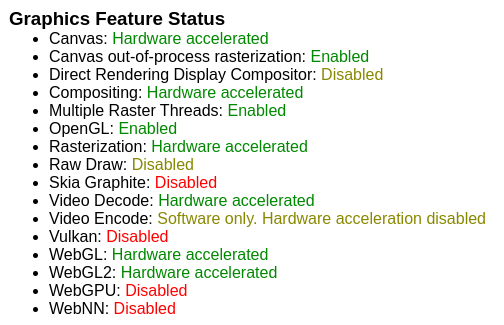Leaflet
- 173 Posts
- 154 Comments

 5·2 days ago
5·2 days agoPhones make the encryption invisible to the user.
That’s not the case on Linux unless you’re willing to put in a bit of work to set up TPM unlocking yourself or use one of the few distros that use TPM by default, like Aeon.
And even then Aeon’s not perfect. Sooner or later the TPM will fail and you’ll have to enter your long backup password and reenroll the TPM.

 31·5 days ago
31·5 days agoThis is my result with the Chromium flatpak with ozone set to auto, AMD GPU.

Even though it says video decode is hardware accelerated, it doesn’t seem to be doing so according to Resources.

 3·6 days ago
3·6 days agoAre you using two separate devices? If so another option could be LocalSend, it allows you to send files over the same network.
I used it for sending a couple hundred GBs of files. Didn’t take too too long. Also avoids unnecessary writes to flash media.

 3·6 days ago
3·6 days agoTo my understanding, the kernel should clean up any memory leaks an app has when you close it.

 3·6 days ago
3·6 days agoI’m not sure if it is related to Newsflash is the problem. Besides, I’ve been using the same version for months, but this has only recently become a problem. And the problem persists after Newsflash is closed.

 4·6 days ago
4·6 days agoNo integrated GPU.

 32·7 days ago
32·7 days agoResources reports the same memory usage as btop. free tells me only 6GB is being used for cache.
On a fresh boot, Resources and btop report less than 2GB RAM usage, obviously not including cached stuff. So for both tools to report 18GB with no apps open, it’s strange.
ps aux looks all normal, nothing in the background using more than 1% of RAM.
Using Fedora Silverblue 41 with btrfs.

 1·7 days ago
1·7 days agoNo large files.

 1·7 days ago
1·7 days agoAll normal

 30·10 days ago
30·10 days agoBetter game performance in some scenarios when running a game natively under Wayland. It helps to minimize GPU downtime when it could instead be rendering.

 2·10 days ago
2·10 days agoI was using a 1660 Ti around 3 years ago and I don’t remember it being this stuttery, even on Wayland. If this is a problem on newer NVIDIA cards, then I think I might have to go AMD again despite the worse raytracing. I wanted to get an upgrade before upcoming tariffs affect graphics card prices.

 19·10 days ago
19·10 days agoThey call Bazzite cloud native because they use a lot of technology often used in the cloud, but it’s still a locally run OS with no dependence on the internet apart from getting new updates.
Unlike traditional distros, it uses flatpak for apps, comes with podman (similar to docker) if you want to use containers, and has a more robust update mechanism.
ProtonVPN is on Flathub, I’ve had no issues with it.
I just listed the changes since GIMP 3 RC1.
Over GIMP 2.10.38, there’s a lot of changes. Better color management, GTK 3, non-destructive editing, and other stuff I can’t remember.
That last one is a major boon. It means you could perform an action on a layer, say raise the exposure, but revert it later on without affecting the quality or losing information. Unfortunately this doesn’t apply to all actions (such as resizing), but the list of non-destructive actions will grow later on.
By far the most important thing I’ve done is created a list of all the package names. With just one command, I can reinstall all my apps.
The second most important thing I’ve done is created a long list of gsettings/dconf commands that configure Gnome to my liking.
I’ve also moved most of my user data off my OS drive to removable drives. But I don’t have my home on a separate drive since I don’t want to share that across different distros since they configure things differently. It’s also just a lot easier to not have a separate home.
Apart from that, the script I have also copies over some config files, sets my hostname, sets flatpak overrides.
Fixed settings migration from 2.10
Implemented new GEGL API earlier than planned since plugin makers really wanted it
They renamed the nightly flatpak so you can have the stable and nightly versions installed alongside each other.
Are you using fractional scaling?

 9·24 days ago
9·24 days agoYup. Or at the very least, a distro package’s listed dependencies don’t show you the true dependencies a program needs to function. There are a lot of dependencies that are needed but not listed because they are installed through transitively by other packages.
Rust shows you the true scale because it’s statically linked. That being said, Rust really may use more dependencies, but directly comparing the number of dependencies can be misleading without considering the scope and focus of each dependency.

 5·27 days ago
5·27 days agoIs the Windows drive listed in your /etc/fstab?



The virt-manager flatpak doesn’t work out of the box, you need to do some setup on the host. At that point you may as well use the deb of virt-manager.